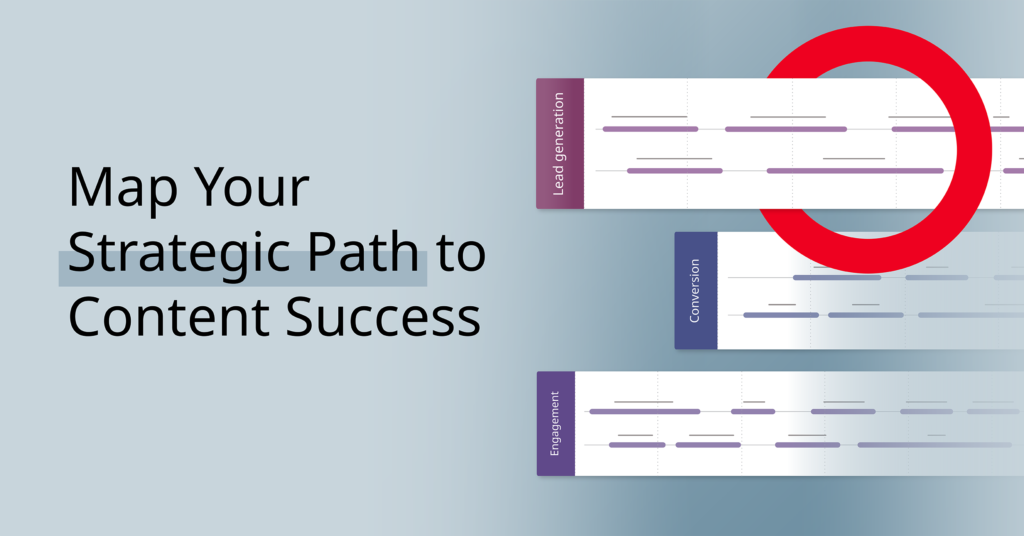For any successful journey, you must know where you are, where you want to be, and what paths you can take to get there. Similar to traveling in a GPS-equipped car, a content strategy roadmap can help you make complex content decisions and achieve your goal.
What is a Content Strategy Roadmap?
A content strategy roadmap is a high-level plan for achieving your marketing goals. It provides an overarching overview of content development and distribution at each stage of the marketing funnel (awareness, consideration, and decision). It should include key initiatives, who will be responsible for each initiative, and deadlines for their completion.
While a content strategy roadmap is similar to a content calendar, it is more comprehensive. The focus is on the high-level steps to achieve high-level goals rather than the fine, tactical details of individual content creation. Think of it as a macro view of your content marketing plan to help you stay on track on your path to success. (For more information on creating a content calendar, see the sidebar below.)
Essential components of a content roadmap
A content roadmap should provide a clear overview without diving too deeply into specific action steps. When you’re ready to create it, keep in mind the important elements that should be included:
- Target group: Who you want to reach
- Goals: What do you want the audience to do after engaging with your content?
- Content plan: The types of content you will create and how you will distribute it (e.g. blog posts, white papers, social media)
- Project milestones: Important moments you track like kickoff, first draft, final draft, and release dates
- Stakeholders: The team members responsible for each initiative and any other department partners you may involve as needed.
Create your content roadmap
The first step in developing your roadmap is to determine what priority goals you want to achieve. For example, do you want to grow your customer base, generate leads, convert prospects into customers, engage your audience to improve customer retention, or all of the above? The goals you select are the goals your content roadmap leads to.
Next, assess your existing content – this represents your current location. Identify evergreen assets that can be used as is, content that needs updating, and stories that don’t align with your goals and can be discarded. This process will help you set the starting point for your map.
From there, identify gaps in the path that need to be closed and the effort required to close them. This represents the possible routes you can take to your destination.
Your efforts may include keyword research, working with your sales team, and analyzing customer data to understand what content resonates with your audience. By evaluating these factors, you will determine the milestones you need to achieve throughout your content journey.
Standard features of effective content roadmaps
Although their structure and design can vary depending on the company, effective roadmaps typically have the following characteristics:
- Visual clarity: Your roadmap should be easy to interpret at a glance, whether it’s in the form of a flowchart, timeline, or map.
- A well-organized structure: This helps ensure consistency when multiple team members are involved in developing the roadmap.
- Accessibility: The full journey – and all the steps in between – should be easy to understand for others, including leaders.
- Liquid: The roadmap should be easy to update or revise as your strategy, goals, or customer insights change.
When you’re ready to create your content roadmap, a robust content management system can help streamline the process and make it easier to update, organize, and optimize your content strategy.
How to create an effective content calendar
As industries evolve, marketing teams must move quickly while remaining organized. A content calendar makes this possible by helping you track the content you publish, where and when.
What is a content calendar?
A content calendar is a tool that outlines your publishing schedule across different channels. It can track content for various purposes including blog posts, social media updates, and press releases.
The level of detail may vary, but a well-constructed calendar will keep everyone informed and ensure you’re providing your audience with a consistent stream of quality content.
Three steps to create a content calendar
- Define results: Make sure all business goals and stakeholder priorities are addressed and all assets you plan to produce align with your strategic content roadmap.
- Set a schedule: Establish a realistic content creation cadence based on available team resources. Consider using a content management system to speed up all steps in your publishing process.
- Create and fill: Fill your calendar with important information like topics, channels, due dates, and links to drafts. Don’t forget to note important events or critical topics that resonate with your audience.
Once created, continually evaluate your calendar’s performance and make adjustments to optimize your strategy as new insights come to light.
About Brightspot
Brightspot is your CMS solution for delivering brilliant, modern digital experiences with a flexible, fast and secure platform you can trust to continually improve your content approach. A powerful suite of enterprise-grade tools and templates that can be customized to meet your specific business needs for today and beyond. Our robust, ready-to-use library is fully customizable to meet the needs of your organization, content contributors, and developers. But we don’t stop there: we offer the flexibility to design front-end experiences and ensure content is delivered exactly how you need it. For more information about why Brightspot is the right CMS platform for your business, see our website here. Ready to learn more about how Brightspot can support your digital strategy? Chat with an expert today!

